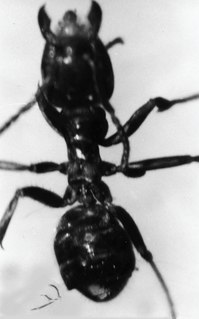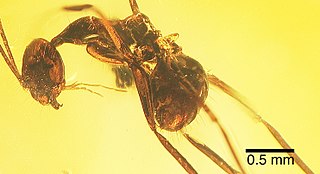Related Research Articles

The common moorhen, also known as the waterhen or swamp chicken, is a bird species in the rail family (Rallidae). It is distributed across many parts of the Old World.
Norman Humbert Joy was a British ornithologist and coleopterist.
Myrmecia inquilina is a species of ant endemic to Australia in the subfamily Myrmeciinae, first discovered in 1955 and described by Athol Douglas and William Brown Jr. in 1959. These ants are large, measuring 21.4 millimetres (0.84 in). During the time of its discovery, Douglas and Brown announced M. inquilina as the first social parasite among the primitive subfamilies, and today it is one of the two known Myrmecia species to have no worker caste. Two host species are known, Myrmecia nigriceps and Myrmecia vindex. Aggression between M. inquilina and its host species does not occur, and colonies may only produce M. inquilina brood months after the inquiline queens begin to lay their eggs. Queens eat the colony brood or trophic eggs, and other Myrmecia species may kill M. inquilina queens if they reject them. Due to its restricted distribution and threats to its habitat, the ant is "vulnerable" according to the IUCN Red List.

The European potter wasp or European tube wasp is a species of potter wasp. As an imago (adult), the female collects as many as 20 caterpillars for each nest, which consists of a single cell. Her larval offspring then feed on these inside the nest, which is sealed with mud arranged by her. As adults, they eat nectar and aphid honeydew. Males cannot sting, and the sting of a female is not painful. They can be found on windows, foraging for nectar on flowers, or searching out small cracks or holes in which to nest.
Neocorynura electra is an extinct species of sweat bee in the Halictidae genus Neocorynura.
Syndesus ambericus is an extinct species of stag beetles in the subfamily Syndesinae known from a single possibly Miocene fossil found on Hispaniola. S. ambericus is the first species of stag beetle to have been described from fossils found in Dominican amber and is one of four species from amber, and the only stag beetle species known from the Caribbean.
Anthophorula (Anthophorula) persephone is an extinct species of bee in the subfamily Apinae known from a pair of possibly Miocene fossils found on Hispaniola. A. persephone is the first species of the bee tribe Exomalopsini to have been described from fossils found in Dominican amber and is the only species of Anthophorula found in the West Indies.

Haidoterminus is an extinct genus of ant in the Formicidae subfamily Haidomyrmecinae, and is one of only nine genera placed in this subfamily. The genus contains a single described species Haidoterminus cippus and is known from one Late Cretaceous fossil which has been found in North America.

Burmomyrma is an extinct genus of ant-mimic wasp in the extinct family Falsiformicidae. The genus contains a single described species, Burmomyrma rossi. Burmomyrma is known from a single Middle Cretaceous fossil which was found in Asia.

Acropyga glaesaria is an extinct species of ant in the subfamily Formicinae known from a group of possibly Miocene fossils found on Hispaniola. A. glaesaria is the first species of the ant genus Acropyga to have been described from fossils found in Dominican amber and is the one of several species of Acropyga found in the West Indies. As with other members of the genus, A. glaesaria was most likely trophobiotic.
Acanthognathus poinari is an extinct species of ant in the subfamily Myrmicinae known from a single possibly Miocene fossil found on Hispaniola. A. poinari is the first species of the ant genus Acanthognathus to have been described from fossils found in Dominican amber and is one of several species of Acanthognathus found in the Greater Antillies.
Psylliodes luridipennis, commonly known as the Lundy cabbage flea beetle or the bronze Lundy cabbage flea beetle, is a species of flea beetle endemic to the island of Lundy, where it lives and feeds upon the endemic Lundy cabbage. Along with the true weevil Ceutorhynchus contractus var. pallipes and an undescribed race of flea beetle Psylliodes napi, it is known only from the Lundy cabbage. The species was first recorded by Thomas Vernon Wollaston in the 1840s, and was named by the Austrian entomologist Franz Kutschera in 1864.

Azteca alpha is an extinct species of ant in the subfamily Dolichoderinae known from possibly Miocene fossils found on Hispaniola. A. alpha is one of only two species in the genus Azteca to have been described from fossils, both found in Dominican amber. It is the host for a fossil nematode, and has been preserved with scale insects.

Zatania electra is an extinct species of ant in the subfamily Formicinae known from three possibly Miocene fossils found on Hispaniola. Z. electra is one of several Zatania species found in the Greater Antilles.
Dicromantispa moronei is an extinct species of mantidfly in the neuropteran family Mantispidae known from a fossil found in the Caribbean.

Elephantomyia (Elephantomyia) longirostris is an extinct species of crane fly in the family Limoniidae. The species is solely known from the Middle Eocene Baltic amber deposits in the Baltic Sea region of Europe. The species is one of six in its genus described from Baltic amber.

Elephantomyia (Elephantomyia) pulchella is an extinct species of crane fly in the family Limoniidae. The species is solely known from the Middle Eocene Baltic amber deposits in the Baltic Sea region of Europe. The species is one of six described from Baltic amber.

Gyaclavator is an extinct genus of lace bug in the family Tingidae known from a fossil found in North America. The genus contains a single species, Gyaclavator kohlsi.

Xylophilus luniger is a beetle that is endemic to New Zealand. This member of the family Aderidae is commonly collected by beating vegetation around the margins of native forest. The species has been collected in the North Island only.

Clanoptilus barnevillei is a species of beetles belonging to the family Melyridae, the soft-winged flower beetles.
References
- ↑ Blair K.G. 1930: Aglyptinus agathidioides sp. n. (fam. Silphidae), a new British beetle. The Entomologist's Monthly Magazine 66: 7–8.
- ↑ Gerlach J. 2014: Extinct animals of the British Isles. p 80. Lulu Press, ISBN 978-1326086039.
- ↑ J. Cooter (1996): Annotated keys to the British Leiodinae (Col., Leiodidae). Entomologist's Monthly Magazine 132: 205-272.